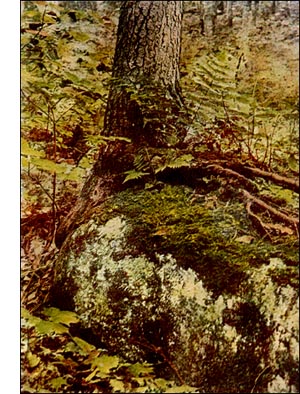Short Stemmed Haircap Moss
 The Short-stemmed Haircap Moss, Pogonatum brevicaule, Beauv.
The Short-stemmed Haircap Moss, Pogonatum brevicaule, Beauv.Habit and habitat.-The short-stemmed Pogonatum is remarkable because of its habit of retaining the protonema, which persists as a bright-green felt covering the ground at the base of the plants. It binds the crumbling earth so that one may gather it in sheets. As the moss commonly grows in clay-banks, in ditches, and in places rather insecure, it may be that the habit of retaining the protonema has been evolved in the struggle for existence to enable it to live in situations too insecure to be occupied by other mosses.
Name.-The specific name brevicaule, from the Latin brevis, short, and caulis, stem, refers to the height of the plant.
Plant (gametophyte).-Short,simple; 1/4 to 1/2 of an inch high. The male plants are minute and budlike.
Leaves.-Five or six, erect, lanceshaped; apex awned; base broad, transparent; margin serrate, with appressed teeth; lamellae few, 5 to 6 cells deep, the terminal one smooth and elliptic in section. Male-cluster leaves erect, curved back from the middle, lapping as shingles, broadly y obcordate; vein passing beyond the apex to form a sharp point.
Leaves at the base of the pedicel.Sheathing, long, membranous, abobtusely serrate point.
Habit of flowering.-Male and female flowers on separate plants (dioicous). Male plants bud-like.
Veil (calyptra).-Hairy, reaching to the base of the spore-case.
Spore-case.-Cylindrical, broadest at the mouth, contracted below the mouth when dry, rough with tiny projections (papillose).
Pedicel (seta).-Twisted, t to 2 inches long.
Lid (operculum).-Flat, with a point at the centre.
Teeth (peristome).-White, simple, of 32 blunt teeth.
Spores.-Mature in winter.
Distribution.-North America; Eastern States, north to Newfoundland, west to Ontario.